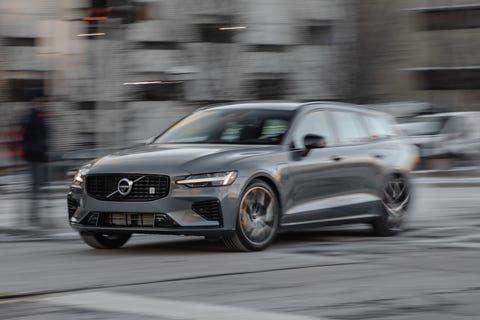
Michael SimariCar and Driver
Transforming Polestar from the performance-tuning arm of Swedish automaker Volvo into an EV-focused brand is the master plan, but we’re happy to report that Polestar is still up to its old upptåg, tuning Volvos into powerhouses. The latest effort is the 2020 Volvo V60 T8 Polestar Engineered station wagon and, like its SUV-equivalent—the XC60 T8 Polestar Engineered—it’s a practical package with a heavy dose of performance.
Our stance on the fuel-economy and handling benefits of station wagons over SUVs is well known. We also don’t need to keep harping on how much better wagons look, especially one that looks as good as the V60. Letting Polestar serve as the V60’s personal trainer only deepens our love of the long-roof car.
A wagon like the $68,295 V60 T8 is a sort of anti-SUV statement, and from the 240 Turbo Wagon to the previous-generation V60 Polestar, Volvo has a long history of building fast wagons. The new V60 is built on Volvo’s scalable architecture that underpins its entire lineup. Polestar has been developing its own lineup of hybrid and EV vehicles, so while the old V60 Polestar was a gas-only affair, the new model leverages the brand’s newfound expertise in electric motors, batteries, and EV engineering to make things both quicker and more efficient.
Differentiation from lesser V60 models is subtle. Look closely and you’ll notice gold brake calipers, unique 19-inch wheels, yellow seatbelts, and a chalk-white Polestar liftgate badge. It’s enough to be handsome, but not so much as to tip anyone off as to what this Volvo wagon is packing.
Two Powertrains
In the T8, Volvo’s turbo- and supercharged 2.0-liter inline-four is assisted by an electric motor. Together the engine and motor combine to put out 415 horsepower and 494 lb-ft of torque. The gas-burning engine runs through an eight-speed automatic transmission and powers the front wheels. An electric motor in back sends power to the rear wheels. At the test track, this arrangement recorded a 4.4-second blast to 60 mph and a 12.9-second quarter-mile pass at 107 mph.
Those numbers mean that the V60 T8 Polestar is quicker than some of our other favorite wagons, including our long-term Mercedes-Benz E450 wagon (4.7 seconds to 60 mph) and the Jaguar XF Sportbrake (5.0 seconds.) It’s quicker than the XC60 T8 Polestar SUV, too, which delivered a 4.8-second zero-to-60-mph time and ran a 13.4-second quarter-mile at 105 mph. Despite a lack of electric propulsion and a 53-hp deficiency compared to the 2020 model, the 2017 V60 Polestar we tested was quicker still, running to 60 mph test in just 4.2 seconds. Blame the weight of the new V60 T8, which, at 4522 pounds, is a significant 556 pounds more than the 2017 version.
So, the old one is quicker. Out on the road, the new V60 will easily frighten any passengers with its acceleration, particularly with a full charge of its battery and running in the Polestar Engineered driving mode. Put your foot in it, and the instantaneous response from the electric motors provide the kind of EV-car shove that Tesla drivers enjoy. The acceleration is accompanied by a faint supercharger whine as the four-cylinder engine hits its stride and both powertrains combine forces to get the V60 moving quickly. In the Polestar Engineered driving mode, the four-banger provides a sonorous burble, but never relies on farts, crackles, or pops to announce its status as a performance vehicle. While it is quick, in more sedate driving the interplay between electric power and a gas engine with a supercharger and turbocharger leads to occasional surges and delays. While it doesn’t amount to much, it’s there.
Polestar hasn’t just added power, though. The V60’s suspension has also been massaged. Pop the hood and you’ll see gold nubbins protruding from the suspension towers. The nubs are how the standard Öhlins dampers are adjusted, and you have to do so manually. That kind of DIY modification is all but unheard of in production vehicles, let alone a luxurious station wagon. The setup is also offered on the XC60 T8 Polestar and even the Polestar 1. It’s unlikely the average buyer will fuss with the dampers. But you know who will? Wagon-loving enthusiasts like us, wrenches in hand, ready to dial in the suspension to how we like it.
Plug-In Efficiency
On the other efficiency side of the spectrum, the electric motor and 11.6-kWh battery pack allows for an EPA rating of 22 miles of purely electric driving. In our experience, that range number seems realistic; our test vehicle motored for 21 miles at 75 mph on battery power before firing up the gas engine. On our 200-mile highway-fuel economy test, the V60 T8 Polestar delivered 31 mpg overall, beating the non-hybrid V60 T6 all-wheel-drive model’s 29 mpg and the XC60 Polestar’s far worse 23 mpg in the same test.
Volvo’s plug-in hybrid system is capable of charging itself using the four-cylinder as a generator, so if you use up all your electrons blasting through mountain passes, you can switch to the charging mode and replenish the battery.
While the intention here was to make a fun-to-drive, performance-oriented car, the V60 T8 Polestar is refined enough to drive to the office every day or for puttering around on errands. In the Comfort driving mode, the uneven power delivery is subdued and the throttle response isn’t as immediate. The ride is definitely firm, so firm it’ll likely wake sleeping children, but if they’re awake they can watch you fiddle with the dampers to improve the ride, something you can’t do in the softer non-Polestar V60.
Volvo and Polestar have created a performance car with the practicality of a wagon and the potential efficiency of an EV, if only for 22 miles. We are thrilled it exists. Volvo could have easily just limited the T8 Polestar treatment to the XC60, but they didn’t. They also gave it to this gorgeous wagon.
Source: Reviews - aranddriver.com





